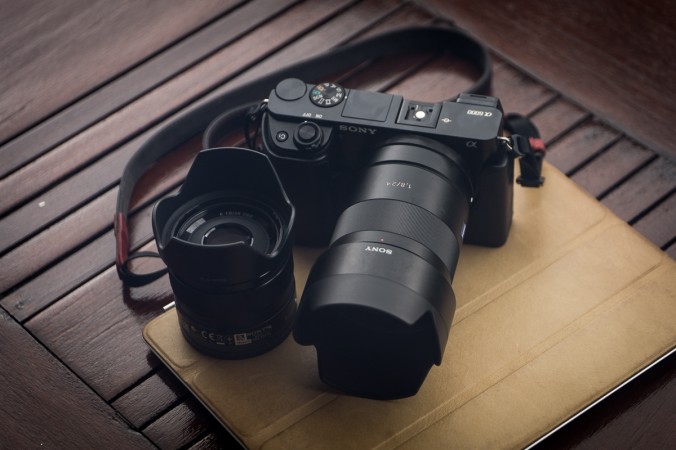Photographic Background
Until July of this year i was a true DSLR lover and user. I never bothered with anything else but a old trusty camera with a flipping mirror inside.
In the middle of the year I did some planning for upcoming trips that would take me across the globe. This reminded me of my last trip to Thailand in late 2013 where I was lugging around my Think Tank messenger bag loaded with two Nikon full frame DSLRs and three lenses with one of them being a 70-200/2.8—and reminded me of the accompanying pain in my back at the end of the day.
With the idea of having a small, compact, yet powerful set-up to take with me to varying trips to London, Spain, Thailand and finally Cape Town slowly building up in my mind, I decided to dive head-on into the mirrorless world.
At first I was taking a look at the low-budget offerings from Fuji (XE-1) and Olympus (OMD EM10). I was quite impressed what Olympus can deliver with the tiny sensor cramped into an even tinier body after just a few minutes of fiddling around in front of my local camera store (www.fotohaus-klinger.de).
So I decided to give the Olympus a chance and they were kind enough to send me the camera with two lenses to take a look. Overall this camera is able to pack quite a punch into a tiny package but it didn’t convince me after all because the body is too small body and has sluggish autofocus performance! I sent it back and came across the Sony a6000, which was quite new at that time. I ordered it via Amazon as an impulse and never regretted it for a second!
Features and Build
Overall it’s a rangefinder style mirrorless camera with EVF located on the left-hand backside, right above the tilting display. Event though it’s not the highest resolution EVF on the market it does the job and it made me miss all the available information on mirrorless when switching back to a DSLR.
It houses a 24 MP sensor with on-sensor phase detection AF with an incredible amount of focus points covering nearly all of the sensor’s surface. It is capable of shooting up 11 frames per second—though it takes quite a while until all these files have cleared the buffer making the camera lock up pretty quick.
Overall the design of the Sony a6000 can be described as streamlined, almost featureless at the front and lots of dials and buttons at the back. All of these buttons are fitted on the right hand side around the comfortable rubber thumbrest so operating the camera single handed comes at ease. The grip protruding at the front is massive for the camera’s overall size which makes it very comfortable to hold even over longer periods of time.
In general, using this camera is quite easy even though not as intuitive as a DSLR. It is indeed very technical with all the stuff you can do and a high level of customization. But Once you get used to it, it lets you navigate through the menu system in a breeze configuring the camera to your special shooting needs!
A few more words about the AF-System as it’s actually quite amazing. Whether you’re using SingleShot mode with a selective focuspoint (you can choose between three sizes) or continuous Af with zone focusing, it never lets you down. The camera locks on subjects almost instantly without any hunting. In low light you need a bit more patience, since it can take a moment or two until the camera sets focus, but it always does and it’s mostly accurate.
That being said I photographed a Christmas party at ISO 10000 and overall got all the shots I wanted. And please show me a DSLR that focuses without any hesitation in a room lit mostly by candles.
Image Quality
Truth to be told this camera is great to use. It has a great AF system, it captures 11 frames per second, it has WiFi and a host of other features but where it shines and stands out is in image quality.
When going through the files and tweaking them in my usual Lightroom workflow I forgot I was using $600 APS-C camera. Dynamic range and ISO performance is just great and did not make me miss a full frame sensor for a second. With the right glass in front of the camera it can deliver stellar sharpness. Sure there is some grain above ISO 320,0 buts it’s pleasant and I rarely shoot above that.
Conclusion
The camera has become my daily companion over the last several months. Its size and weight make it the perfect camera to throw in your bag and take with you wherever you go.
I shoot quite a lot of pictures for my stock agency with it and even use it for some of my personal portfolio work. It came quite close to becoming my main camera, making me leave my Nikon D600 at home on more than one occasion. It packs a bunch of useful features and the amazing IQ in a affordable body backed by good quality lenses that won’t stretch your budget too much.
For me it’s also the perfect travel camera, letting you share your shots on Instagram or Facebook in an instant using the wifi functionality.
It even made me switch systems, ditching my D600 for a Sony a7.
So all in all this camera performs remarkably well in every area making it quite a winner for amateurs and enthusiasts alike aswell as pros looking for a more portable solution to back up their main shooting setup!
[amazon text=Amazon&template=carousel&asin=B00I8BICCG,B00IMP0DN4, B00B7ID9CU, B00GSAEN4A, B00EPWC30O, B00BJGNRR2]
